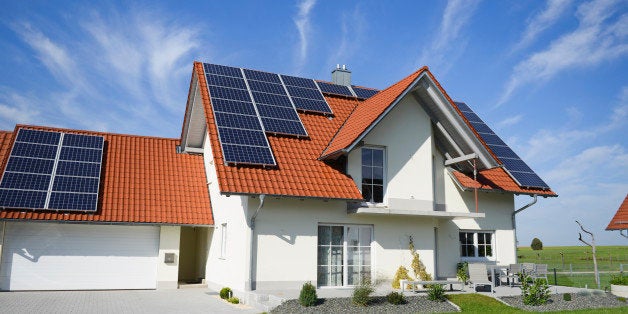
HONOLULU - Major advances in battery storage technology, not to mention sharp cost reductions, could help light the way for Hawaii’s troubled solar industry. The path forward could, it seems increasingly plausible, involve do-it-yourself solar users disconnecting themselves from the power grid altogether, and still flourishing.
And while major questions remain about the cost, the technology and the pace of adaptation of off-the-grid solar, it is significant that there is a possible pathway forward.
The industry has created thousands of new jobs across Hawaii and helped the state meet its renewable energy goals, but it is suffering a period of sudden retrenchment after years of historic growth.
Solar sales began to decline for the first time just this year. Residential sales are down nine percent compared to last year, while commercial sales have plummeted by 50 percent, according to statistics from Hawaii’s Department of Business, Economic Development and Tourism.
Now companies find themselves competing in a shrinking market as they wrestle with the limitations of a public utility that owns the power grids on Oahu, the Big Island and Maui County. The power company sometimes seems like the greatest obstacle to innovation because the electric company can only accommodate so much intermittent solar power on their grids before engineers fear that too much of the energy will cause power disruptions and put utility workers' safety at risk.
As the situation has worsened, some solar company executives have even warned of a possible collapse or at least a significant contraction of the industry.
Some prominent solar executives say that the moment of grid saturation is nearly here. “I’m super duper pessimistic,” Mark Duda, an executive at Honolulu-based RevoluSun, said at a panel discussion on the solar industry in downtown Honolulu on Thursday. “I think this is actually the event we have all been worried about in the past, but I think now we have hit it.”
One reason for the sudden lag in solar sales is likely the increasing constraints that the utilities place on those who are trying to hook up their solar systems to the electric grids, Marco Mangelsdorf, president of Hilo-based ProVision Solar, told the panel at the Plaza Club. (An array of solar executives spoke at the forum, as did Scott Seu, a vice president at Hawaiian Electric Co. and Mike Champley, a commissioner at the Public Utilities Commission.)
In such a situation, the game changer would involve affordable battery storage technology that can hold large amounts of energy from solar panels on a home or business. Battery storage allows customers to liberate themselves from the power company’s limitations — and high prices — and go completely off the traditional power grid, while enjoying a steady flow of power, even at night or when it rains.
That is why the solar industry has long looked at a transformational upgrading of battery storage technology as a sort of holy grail that would illuminate a pathway toward mass solar adoption. But prices for battery storage have traditionally been too high, and the technology has been cumbersome, requiring extensive maintenance. The result is that few people installed batteries.
“Traditionally, if you wanted to go off-grid, or you wanted to have battery backup, you had this mad science experiment on the side of your garage with all these batteries,” said Joseph Saturnia, president of Honolulu’s Island Pacific Energy. “You had to go out once a week and check the water levels. It was just something the average consumer didn’t want to do. And it was expensive.”
That may be changing now as the benefits of multi-million dollar research and development filter into the market, leading to a new generation of cheaper and far higher-capacity batteries.
Saturnia’s company has just released a much simpler new battery storage system that comes in a single compact metal box. He describes it as being as hassle-free to use as solar panels on your roof.
The downside is that the system remains pricey. For an average home, the battery storage system can run $10,000 to $25,000. But with long-term financing options and declining solar photovoltaic prices, the cost can end up penciling out at a price that's competitive with electricity from HECO, said Saturnia.
Not all solar executives believe that battery storage technology is quite ready. Mangelsdorf worries the systems can still be a hassle and he doubts that the stiff price will make mass adoption of the technology possible anytime soon.
And he may be right.
On the other hand, growing customer anger over Hawaii’s electricity prices, which are three times the national average, and the increasing frustration of many solar users who struggle to get their systems hooked up to the utility company’s electric grids, just add to temptation to break away from the grid.
And as the cost of solar and battery storage decline further, it may well become more difficult for the power company to convince customers “to remain grid-tied” when they could shift toward an easy new alternative, said Duda.
As the amount of solar energy on the utility's circuits grows, customers seeking to connect their panels to HECO's grids are encountering increasing delays, obstacles and costs. Residents can be charged for studies to ensure that their system won’t disrupt the electric grid, as well as for circuit upgrades.
The utility has recently taken steps to ease this burden for customers by doing a single study for multiple systems and by increasing the circuit threshold that triggers a study. But, Champley said, "Until we solve the problem with the grid we are going to hit a wall."
About 200 solar customers are currently in solar limbo as the utility works to figure out how to safely hook up the systems, said Seu of Hawaiian Electric.
He noted that the utility is focused on upgrading its grids to accommodate more solar, but he stressed that it faces a growing challenge as more and more people shift to solar.
“It’s getting harder ... from a technical perspective,” Seu said. “It’s getting harder from a commercial perspective. And it’s getting harder from a customer perspective."
An exodus of customers off of the grid could potentially upend the utilities’ current business model. But Seu said that improved battery storage, as well as other technology, could also help the utility integrate more solar energy by smoothing out the power as it enters its grids.
It’s a point that Saturnia agrees with. In addition to using Island Pacific Energy's battery storage technology to disconnect from the grid, the battery systems can also function while remaining connected to it.
Saturnia argues that the private sector should play a key role in innovation, rather than placing all of the burden on the utility to respond to limitations of the current grid.
